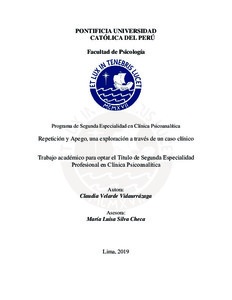| dc.contributor.advisor | Silva Checa, María Luisa | |
| dc.contributor.author | Velarde Vidaurrázaga, Claudia | |
| dc.date.accessioned | 2023-06-01T21:13:36Z | |
| dc.date.available | 2023-06-01T21:13:36Z | |
| dc.date.created | 2019 | |
| dc.date.issued | 2023-06-01 | |
| dc.identifier.uri | http://hdl.handle.net/20.500.12404/25105 | |
| dc.description.abstract | En el presente trabajo se presentará el análisis clínico de una paciente mujer de 25 años en sus
sesiones iniciales de terapia psicoanalítica, utilizando el modelo de formulación psicodinámica de
casos de Alessandra Lemma (2016). Se realiza un contraste entre el trabajo clínico durante estas
sesiones con la teoría que ofrecen algunos autores para ayudar a ilustrar y entender el proceso. Se
utilizaron las ideas que ofrece Winnicott acerca del uso de la agresión como algo necesario para la
constitución y el desarrollo de una vida psíquica saludable (1950) y sobre la búsqueda de la
repetición como un intento de dar una oportunidad al ambiente de responder de manera diferente
y, así, poder desarrollarse de una manera más saludable (1971), en contraposición a la compulsión
de repetición que plantea Freud (1920) como una manifestación de la pulsión de muerte. También
se revisan ideas acerca de la relación que los sujetos tienen con sus padres (Freud, 1932; Anzieu,
1996 & Benjamin, 1996) con el fin de complementar la comprensión del caso. | es_ES |
| dc.description.abstract | The present article will present the clinical analysis of a 25 years old female patient in her initial
sessions of psychoanalytic psychotherapy, using the psychodynamic formulation model of clinical
cases of Alessandra Lemma (2016). This article makes a contrast between the clinical
psychotherapeutic work during these sessions with the theory offered by some authors to help
illustrate and understand the process. Some of the ideas used for this task are Winnicott´s idea
about the use of aggressiveness as something useful for the construction and development of a
healthy psychic life (1950) and about the repetition as an attempt to give the environment an
opportunity to respond in a different way and by that, being able to develop in a better way (1971),
as opposed to the compulsion to repeat that Freud (1920) proposes as a manifestation of the death
drive. Also there is a review of ideas about relationships between subjects and their parents (Freud,
1932; Anzieu, 1996 & Benjamin, 1996) to enrich the understanding of the case. | es_ES |
| dc.language.iso | spa | es_ES |
| dc.publisher | Pontificia Universidad Católica del Perú | es_ES |
| dc.rights | info:eu-repo/semantics/closedAccess | es_ES |
| dc.subject | Psicoterapia | es_ES |
| dc.subject | Psicoanálisis | es_ES |
| dc.subject | Agresividad (Psicología) | es_ES |
| dc.title | Repetición y Apego, una exploración a través de un caso clínico | es_ES |
| dc.type | info:eu-repo/semantics/bachelorThesis | es_ES |
| thesis.degree.name | Segunda Especialidad en Clínica Psicoanalítica | es_ES |
| thesis.degree.level | Título Profesional | es_ES |
| thesis.degree.grantor | Pontificia Universidad Catolica del Peru. Facultad de Psicología | es_ES |
| thesis.degree.discipline | Clínica Psicoanalítica | es_ES |
| renati.advisor.dni | 06652806 | |
| renati.advisor.orcid | https://orcid.org/0009-0002-2394-2351 | es_ES |
| renati.author.dni | 44766790 | |
| renati.discipline | 313019 | es_ES |
| renati.level | https://purl.org/pe-repo/renati/level#tituloSegundaEspecialidad | es_ES |
| renati.type | https://purl.org/pe-repo/renati/type#trabajoAcademico | es_ES |
| dc.publisher.country | PE | es_ES |
| dc.subject.ocde | https://purl.org/pe-repo/ocde/ford#5.01.00 | es_ES |






